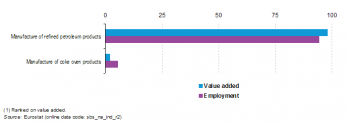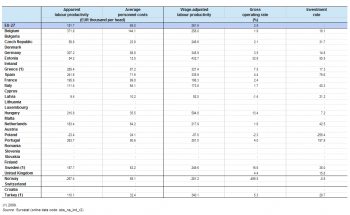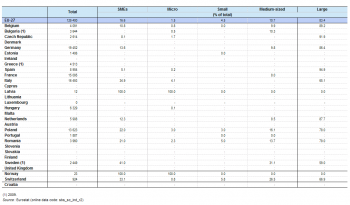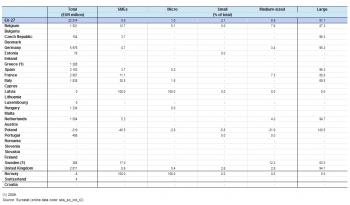Archive:Manufacture of coke and refined petroleum products statistics - NACE Rev. 2
This Statistics Explained article is outdated and has been archived - for recent articles on structural business statistics see here.
- Data from April 2013. Most recent data: Further Eurostat information, Main tables and Database.
This article presents an overview of statistics for the coke and refined petroleum products manufacturing sector in the European Union (EU), as covered by NACE Rev. 2 Division 19.


(% share of sectoral total) - Source: Eurostat (sbs_na_ind_r2)







(% share of sectoral total) - Source: Eurostat (sbs_sc_ind_r2)


Main statistical findings
Structural profile
There were approximately 1 120 enterprises in the EU-27’s coke and refined petroleum products manufacturing sector (Division 19) in 2010. These enterprises generated EUR 23.5 billion of value added and employed 129.4 thousand persons. As such, the coke and refined petroleum products manufacturing sector contributed 0.1 % of the non-financial business economy (Sections B to J and L to N and Division 95) workforce and 0.4 % of its value added; alternatively, the EU-27’s coke and refined petroleum products manufacturing sector represented 0.4 % of manufacturing (Section C) employment and 1.5 % of manufacturing value added.
The fact that this sector’s shares of manufacturing and non-financial business economy value added were higher than its corresponding shares based on employment indicates that the coke and refined petroleum products manufacturing sector had an above average apparent labour productivity. In 2010, value added per person employed averaged EUR 181.7 thousand for the EU-27’s coke and refined petroleum products manufacturing sector, about 3.4 times the manufacturing average (EUR 52.8 thousand) and even further above the non-financial business economy average (EUR 44.8 thousand). This level of apparent labour productivity was the highest among the manufacturing NACE divisions in 2010.
Equally, average personnel costs within the EU-27’s coke and refined petroleum products manufacturing sector were high, at EUR 69.5 thousand per employee in 2010. This was the highest level in 2010 among all of the manufacturing NACE divisions and the second highest among the non-financial business economy NACE divisions, behind the extraction of crude petroleum and natural gas (Division 06). For comparison, the manufacturing average was EUR 35.8 thousand per employee and the non-financial business economy average was EUR 30.9 thousand per employee.
The result of these high levels of apparent labour productivity and average personnel costs was a wage-adjusted labour productivity ratio for the EU-27’s coke and refined petroleum products manufacturing sector of 261.6 %, the third highest among the manufacturing NACE divisions in 2010.
By contrast, the gross operating rate for the EU-27’s coke and refined petroleum products manufacturing sector was just 2.9 % in 2010, the lowest figure for this ratio among the manufacturing NACE divisions, and the second lowest among all non-financial business economy divisions. The gross operating rate shows the relation between the gross operating surplus and turnover, and was brought down by this sector’s very high turnover: coke and refined petroleum products manufacturing accounted for 2.1 % of turnover in the EU-27’s non-financial business economy, a far higher share than recorded for value added or employment.
Sectoral analysis
The coke and refined petroleum products manufacturing sector comprises two subsectors: the manufacture of coke oven products (Group 19.1) and the manufacture of refined petroleum products (Group 19.2). Within the EU-27 the coking subsector was by far the smallest in 2010, for example, contributing 5.6 % of sectoral employment, 2.0 % of sectoral value added, and 0.6 % of sectoral turnover.
Because of its dominance, the EU-27’s petroleum refining subsector recorded expenditure, productivity and profitability ratios that were similar to those for the sector as a whole: with high apparent labour productivity (EUR 188.6 thousand per person employed), average personnel costs (EUR 72.1 thousand per employee) and wage-adjusted labour productivity (261.6 %) and a very low gross operating rate (2.9 %). Among the EU-27’s manufacturing NACE groups, the petroleum refining subsector recorded the highest apparent labour productivity ratio in 2010, the highest level of average personnel costs (fourth highest within the non-financial business economy), and the lowest gross operating rate (fourth lowest within the non-financial business economy).
An analysis of the coking subsector shows a very different profile — although it is important to bear in mind that this is a relatively small subsector within the EU-27 and that at least 12 Member States did not have any enterprises active within this subsector in 2010. Furthermore, the EU-27’s activity in the coking subsector is heavily concentrated in Poland, which accounted for more than two thirds of the EU-27’s value added and close to three fifths of the workforce. Apparent labour productivity for the EU-27’s coking subsector was EUR 64.9 thousand per person employed in 2010, above the manufacturing average (EUR 52.8 thousand). Average personnel costs were particularly low, EUR 24.6 thousand per employee for the coking subsector, around two thirds of the manufacturing average (EUR 35.8 thousand). One characteristic common between the petroleum refining and coking subsectors was a relatively high wage-adjusted labour productivity ratio: for coking this reached 263.4 % in 2010, well above the manufacturing and non-financial business economy averages (148.0 % and 144.8 % respectively) and also slightly higher than for the petroleum refining subsector. The EU-27 coking subsector also recorded a gross operating rate (10.5 %) that was above the manufacturing average (9.0 %).
Country analysis
The coke and refined petroleum products manufacturing sector was less concentrated in the largest EU Member States than is typically the case for manufacturing activities. Germany had the largest share of EU-27 value added in this sector, 25.4 % in 2010, followed by France (12.6 %) and the United Kingdom (12.0 %). Spain, Italy, Belgium, Hungary and Greece (2009 data) all recorded shares between 10.0 % and 5.0 % of the EU-27 total. The 5.7 % share of EU-27 value added recorded for Hungary and the 6.5 % share recorded for Belgium were the highest shares for these two Member States in any of the non-financial business economy NACE divisions (with data available) in 2010; the share recorded in Estonia (0.3 %) was its third highest contribution.
The relative importance of the coke and refined petroleum products manufacturing sector was particularly high in Hungary where it contributed 2.9 % of non-financial business economy value added in 2010, some 7.3 times the average for the EU-27. Estonia (1.1 %), Belgium (0.9 %) and Portugal (0.6 %) were also relatively specialised in this sector. As noted above, Poland dominated the coking subsector within the EU-27: it contributed 68.4 % of EU-27 value added in this subsector and 59.9 % of the workforce; as a consequence Poland was by far the most specialised Member State in this subsector.
The wage-adjusted labour productivity was particularly high for Estonia in the coke and refined petroleum products manufacturing sector, reaching 432.7 % in 2010, the second highest ratio among all NACE divisions in the Estonian non-financial business economy. In a similar fashion, this sector had the third highest wage-adjusted labour productivity ratio among Hungarian non-financial business economy NACE divisions in 2010 (594.6 %).
Size class analysis
The EU-27’s coke and refined petroleum products manufacturing sector was one of five manufacturing NACE divisions which were dominated by large enterprises (employing 250 or more persons). Large enterprises employed 83.4 % of the workforce and generated 91.1 % of total value added in 2010. These were the second highest shares for any of the manufacturing NACE divisions, while among all non-financial business economy NACE divisions they marked the third highest share of value added for large enterprises and the fifth highest share of employment. Due to the higher share in value added terms, large enterprises not only dominated the coke and refined petroleum products manufacturing sector but they also had by far the highest apparent labour productivity: EUR 198.5 thousand per person employed compared with an average for small and medium-sized enterprises (SMEs, employing fewer than 250 persons) of EUR 97.8 thousand per person employed.
For 12 of the EU Member States there are data concerning the share of SMEs and large enterprises in the coke and refined petroleum products manufacturing sector. In Luxembourg there were no enterprises in this sector, while in Latvia there were no large enterprises. Aside from these two cases, the share of large enterprises in the value added of the coke and refined petroleum products manufacturing sector was at its lowest in Italy (69.5 %), and thereafter ranged from 83.0 % in Sweden (2009 data) to 96.3 % in both the Czech Republic and Spain. Above this share was the special case of the relatively large Polish coke and refined petroleum products manufacturing sector, where negative value added for the sector as a whole and for all size classes except for large enterprises makes interpretation of the size class data problematic. An analysis based on employment shows that the coke and refined petroleum products manufacturing sector employed 13.6 thousand persons in Poland — more than one tenth of the EU-27 total — 78.0 % of which were employed in large enterprises, a share that was slightly below the EU-27 average (83.4 %).
Data sources and availability
The analysis presented in this article is based on the main dataset for structural business statistics (SBS) and size class data, all of which are published annually.
The main series provides information for each EU Member State as well as a number of non-member countries at a detailed level according to the activity classification NACE. Data are available for a wide range of variables.
In structural business statistics, size classes are generally defined by the number of persons employed. A limited set of the standard structural business statistics variables (for example, the number of enterprises, turnover, persons employed and value added) are analysed by size class, mostly down to the three-digit (group) level of NACE. The main size classes used in this article for presenting the results are:
- small and medium-sized enterprises (SMEs): with 1 to 249 persons employed, further divided into;
- micro enterprises: with less than 10 persons employed;
- small enterprises: with 10 to 49 persons employed;
- medium-sized enterprises: with 50 to 249 persons employed;
- large enterprises: with 250 or more persons employed.
Context
This article presents an overview of statistics for the coke and refined petroleum products manufacturing sector in the EU, as covered by NACE Rev. 2 Division 19. This division includes processing services and own-account manufacture of characteristic products through the transformation of crude petroleum and coal into usable products.
Coke oven products include the operation of coke ovens, the production of coke, semi-coke, pitch, pitch coke, coke oven gas, crude coal and lignite tars and the agglomeration of coke.
Refining crude petroleum includes the manufacture of liquid or gaseous fuels or other products from crude petroleum, bituminous minerals or their fractionation products. Petroleum refining involves one or more of the following activities: fractionation; straight distillation of crude oil; and cracking. Included are the production of motor fuel, light, medium and heavy fuel oil, refinery gases, oil-based lubricating oils or greases, road coverings, the blending of biofuels, and the production of a range of other products such as white spirit, paraffin wax and petroleum jelly.
This NACE division is composed of two groups:
- the manufacture of coke oven products (Group 19.1);
- the manufacture of refined petroleum products (Group 19.2).
This division includes the manufacture of gases such as ethane, propane and butane if these are produced as products from petroleum refineries; otherwise, the manufacture of these gases is classified as part of chemical manufacturing (Division 20) which also includes the manufacture of petrochemicals from refined petroleum. Furthermore, the manufacture of fuel gas other than petroleum gases (for example, coal gas, water gas, producer gas, gasworks gas) is classified as part of electricity, gas, steam and air conditioning supply (Section D).
See also
- Manufacturing
- Other analyses of the business economy by NACE Rev. 2 sector
- Structural business statistics introduced
Further Eurostat information
Publications
- European business - facts and figures (online publication)
- Key figures on European Business – with a special feature section on SMEs – 2011 edition
Main tables
Database
- SBS - industry and construction (sbs_ind_co)
- Annual detailed enterprise statistics - industry and construction (sbs_na_ind)
- Annual detailed enterprise statistics for industry (NACE Rev. 2 B-E) (sbs_na_ind_r2)
- SMEs - Annual enterprise statistics by size class - industry and construction (sbs_sc_ind)
- Industry by employment size class (NACE Rev. 2 B-E) (sbs_sc_ind_r2)
- Annual detailed enterprise statistics - industry and construction (sbs_na_ind)
- SBS - regional data - all activities (sbs_r)
- SBS data by NUTS 2 regions and NACE Rev. 2 (from 2008 onwards) (sbs_r_nuts06_r2)
Dedicated section
Source data for tables and figures (MS Excel)
Other information
- Decision 1578/2007/EC of 11 December 2007 on the Community Statistical Programme 2008 to 2012
- Regulation 295/2008 of 11 March 2008 concerning structural business statistics